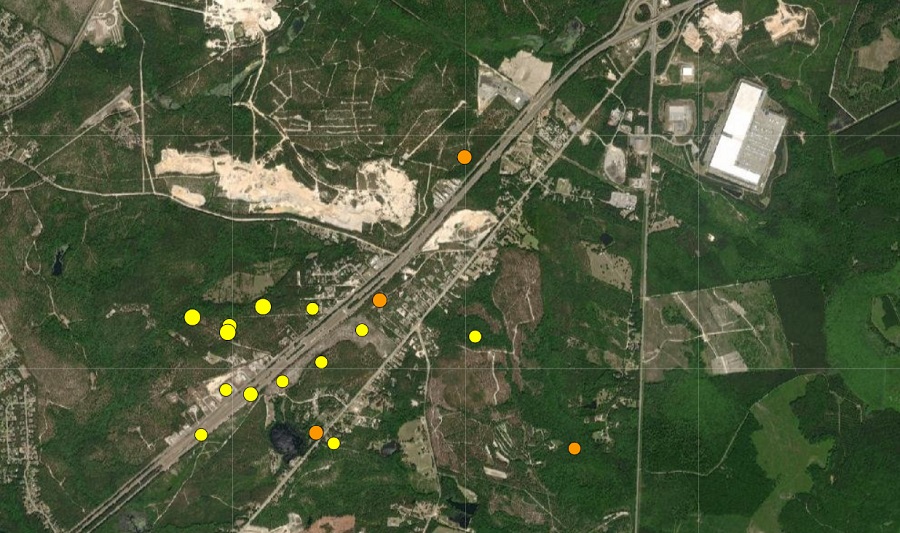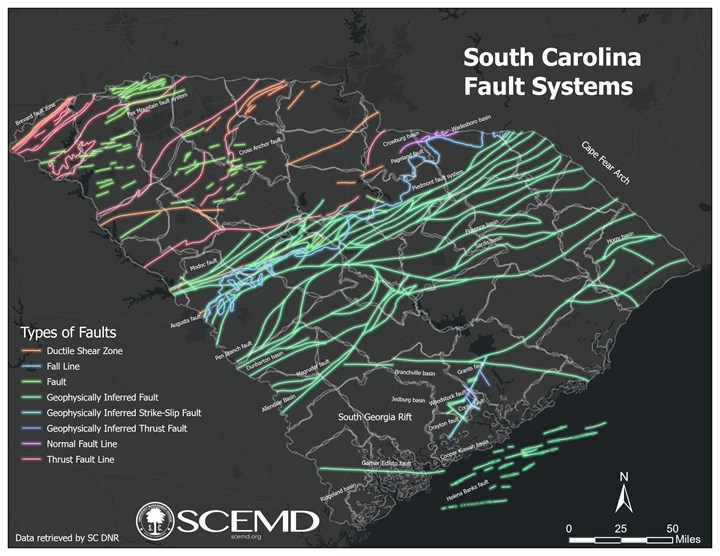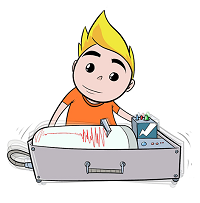
South Carolina officials have announced they are working on scheduling a special earthquake meeting as quakes continue to shake the state, rattling nerves across the region. Officials within the town of Elgin announced they are coordinating an event with Kershaw County and state officials to put together a town hall meeting for residents and business owners to discuss the recent earthquake swarm.
Geologists studying the ongoing swarm of earthquakes in Kershaw County believe this may be the longest period of successive earthquake activity in the state’s recorded history. This swarm began December 27, 2021, with a magnitude 3.3 earthquake centered near Elgin, South Carolina. Since then, more than 47 low-magnitude earthquakes have occurred in the Elgin-Lugoff area, with the strongest being a magnitude 3.6 on June 29.

According to USGS, a swarm is a sequence of mostly small earthquakes with no identifiable mainshock. “Swarms are usually short-lived, but they can continue for days, weeks, or sometimes even months,” USGS adds. However, the South Carolina event doesn’t fit the typical definition of a swarm since the first event was substantially larger than the rest.
According to USGS, “aftershocks” are a sequence of earthquakes that happen after a larger mainshock on a fault. “Aftershocks occur near the fault zone where the mainshock rupture occurred and are part of the ‘readjustment process’ after the main slip on the fault,” says USGS. However, aftershocks of a 3.3 magnitude earthquake would only last a few days, not the week plus they have.
According to the South Carolina Emergency Management Division (SCEMD), there are approximately 10-15 earthquakes every year in South Carolina, with most not felt by residents; on average, only 3-5 are felt each year. Most of South Carolina’s earthquakes are located in the Middleton Place-Summerville Seismic Zone. The two most significant historical earthquakes to occur in South Carolina were the 1886 Charleston-Summerville earthquake and the 1913 Union County earthquake. The 1886 earthquake in Charleston was the most damaging earthquake to ever occur in the eastern United States; it was also the most destructive earthquake in the U.S. during the 19th century.
South Carolina has experienced thousands of earthquakes like these throughout the state’s history, according to State Geologist Scott Howard. What makes these unique is the length of time over which they are occurring. “These earthquakes are now the longest running series of earthquakes in recent history,” Howard said. “Unlike earthquake swarms occurring elsewhere in the country, these have been low in magnitude and haven’t posed a hazard to people, fortunately.”

“The Piedmont Fault System is made up of several smaller fault lines that stretch across the middle of South Carolina.” explained Dr. Steven C. Jaume’ with the College of Charleston’s Department of Geology and Environmental Geosciences Department, “The first earthquake on December 27 appears to be the one that started this swarm in Kershaw County. When an earthquake occurs in a region where there hasn’t been much activity over a long period of time, we can expect similar earthquakes to occur in that general area for the foreseeable future.”
According to SCEMD, both Juame’ and Howard have confirmed there isn’t a man-made cause behind these quakes. There are no mining or fracking operations around that would trigger all of the shaking experienced in South Carolina.
While USGS doesn’t think a larger earthquake is imminent, state officials are urging caution to residents, informing them of how they can be prepare for future earthquakes, including major ones.
“We know our state was at the center of major earthquakes in the past. We all need to be prepared for the possibility of a large-scale earthquake, however unlikely the possibility may be,” SCEMD Director Kim Stenson said, “Check your insurance policies, conduct a home hazard hunt and practice Drop, Cover, Hold On. Those are all things you can do right now to make sure you’re prepared for earthquakes.”

Experts are concerned that a large scale earthquake will strike at some point of the future and bring about significant damage and loss of life. While more than 100 years have passed since the last large earthquake, a 2001 study titled “Comprehensive Seismic Risk and Vulnerability Study for the State of South Carolina” confirmed the state is extremely vulnerable to earthquake activity. The study, based on scientific research, provided information about the likely effects of earthquakes on the current population and on modern-day structures and systems, including roadways, bridges, homes, commercial and government buildings, schools, hospitals and water and sewer facilities.
The last major earthquake event unfolded in Charleston in 1886. That earthquake claimed 60 lives and produced more than $186 million dollars (in 2022 dollars) in damage. Both numbers are remarkable considering how small the population in the southeast was at that time. In addition to damaging more than 2,000 buildings throughout the southeast, that quake, estimated to be a magnitude 7.3 event, was strong enough to be felt as far away as Chicago, Illinois, Boston, Massachusetts, and New Orleans, Louisiana.
Kershaw County is distributing a South Carolina Earthquake Guide to residents online; they share these safety tips for people throughout the state:
- BEFORE AN EARTHQUAKE
- Check for Hazards in your Home
- Fasten shelves securely to walls
- Place large or heavy objects on lower shelves
- Store breakable items such as bottled foods, glass and china in low, closed cabinets with latches
- Hang heavy items such as pictures and mirrors away from beds, couches, and anywhere people sit
- Brace overhead light fixtures
- Repair defective electrical wiring and leaky gas connections. These are potential fire risks
- Secure water heathers by strapping them to the wall studs and bolting them to the floor
- Repair any deep cracks in ceilings ad foundations. Get expert advice if there are signs of structural defects
- Store weed killers, pesticides, and flammable products securely in closed cabinets with latches and on bottom shelves
- Identify Safe Places Indoors and Outdoors
- Under sturdy furniture, such as heavy desks or tables
- Against inside walls
- Away from where glass could shatter around windows, mirrors or pictures and where heavy bookcases or other heavy furniture could fall; and
- In the open, away from buildings, trees, telephone, electrical lines, overpasses or elevated expressways
- Educate Yourself and Family Members
- Practice “Drop, Cover, and Hold On” drills
- Teach children how and when to call 911, police or fire departments and which radio stations broadcast emergency information; and
- Teach all family members how and when to turn off gas, electricity and water
- Have Disaster Supplies on Hand
- Flashlight and extra batteries
- Portable battery-operated radio and extra batteries
- First-aid kit and manual
- Emergency food and water
- Non-electric can opener
- Essential medicines
- Cash and credit cards
- Sturdy shoes
- Develop an Emergency Communication Plan
- In case family members are separated from one another during an earthquake (a real possibility during the day when adults are at work and children are at school), develop a plan for reuniting after the disaster
- Ask an out-of-state relative or friend to serve as the “family contact.” After a disaster, it’s often easier to call long distance. Make sure everyone in the family knows the name, address, and phone number of the contact person.
- DURING AN EARTHQUAKE
- If Indoors:
- DROP to the ground, take COVER by getting under a sturdy table or other piece of furniture and HOLD ON until the shaking stops. If there isn’t a table or desk near you, cover your face and head with your arms and crouch in an inside corner of the building
- Stay away from glass, windows, outside doors and walls and anything that could fall, such as lighting fixtures or furniture
- Stay in bed if you are there when the earthquake strikes. Hold on and protect your head with a pillow unless you are under a heavy light fixture that could fall. In that case, move to the nearest safe place
- Use a doorway for shelter only if it is in close proximity to you and if you know it is a strongly supported, load-bearing doorway
- Stay inside until the shaking stops and it’s safe to go outside. Research has shown that most injuries occur when people inside buildings attempt to move to a different location inside the building or try to leave
- Be aware that the electricity may go out or the sprinkler systems or fire alarms my turn on
- DO NOT use elevators
- If Outdoors:
- Stay there
- Move away from buildings, streetlights, and utility wires
- Once in the open, stay there until the shaking stops. The greatest danger exists directly outside buildings, at exits and alongside exterior walls
- Ground movement during an earthquake is seldom the direct cause of death or injury. Most earthquake-related casualties result from collapsing walls, flying glass and falling objects
- If in a Moving Vehicle:
- Stop as quickly as safety permits and stay in the vehicle
- Avoid stopping near or under buildings, trees, overpasses and utility wires
- Proceed cautiously once the earthquake has stopped
- Avoid roads, bridges or ramps that might have been damaged by the earthquake
- If Trapped Under Debris:
- Do not light a match
- Do not move about or kick up dust
- Cover your mouth with a handkerchief or clothing
- Tap on a pipe or wall so rescuers can locate you
- Use a whistle if one is available
- Shout only as a last resort. Shouting can cause you to inhale dangerous amounts of dust
- AFTER AN EARTHQUAKE
- Expect aftershocks. These secondary shockwaves are usually less violent than the main quake, but can be strong enough to do additional damage to weakened structures and can occur in the first hours, days, weeks, or even months after the quake
- Listen to a battery-operated radio or television. Listen for the last emergency information
- Use the telephone only for emergency calls
- Open cabinets cautiously. Beware of objects that can fall off shelves
- Stay away from damaged areas. Stay away unless your assistance has been specifically requested by police, fire or relief organizations
- Return home only when authorities say it is safe
- Help injured or trapped persons. Remember to help your neighbors who may require special assistance such as infants, the elderly and people with disabilities. Give first aid where appropriate. Do not move seriously injured persons unless they are in the immediate danger of further injury. Call for help.
- Clean up spilled medicines, bleaches, gasoline or other flammable liquids immediately. Leave the area if you smell gas or fumes from other chemicals
- Inspect the entire length of chimneys for damage. Unnoticed damage could lead to a fire.
- Inspect utilities. Check for gas leaks. If you smell gas or hear blowing or hissing noise, open a window and quickly leave the building. Turn off the gas at the outside main valve if you can and call the gas company from a neighbor’s home. If you turn off the gas for any reason, it must be turned back on by a professional.
- Look for electrical system damage. If you see sparks or broken or frayed wires or if you can smell hot insulation, turn off the electricity at the main fuse box or circuit breaker. If you have to step in water to get to the fuse box or circuit breaker, call an electrician first for advice.
- Check for sewage and water lines damage. If you suspect sewage lines are damaged, avoid using the toilets and call a plumber. If water pipes are damaged, contact the water company and avoid using water from the tap. You can obtain safe water by melting ice cubes.